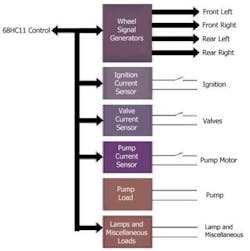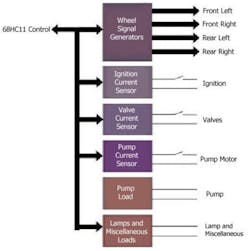Another Look at Environmental Testing of Multiple Products
In the world of testing, many applications do not readily lend themselves to the more classical approaches for functional testing. These include product-life testing, environmental stress screening, module conditioning, and product aging.
Product-life testing requires extended testing periods designed primarily to verify mean time between failures or similar product-life-related statistics. Environmental stress screening, most often associated with military avionics and electronics, usually is a relatively long-duration testing process that verifies operation of a product throughout its entire envelope of operation.
Module conditioning resembles environmental stress screening but tends to be more functional than parametric in nature. This type of testing often is associated with safety-related products such as automobile anti-lock brakes and airbag systems where it is necessary to verify a product’s operation over an extended range of temperature, humidity, and shock. Such testing generally requires eight to 16 hours to conduct and represents a significant restriction for high-volume production lines.
Finally, product-aging testing is associated with new technology displays. In this test, it is necessary to slowly ramp power to a semiconductor device prior to its exposure to rated voltage.
These testing environments share a number of significant characteristics:
-
Multiple units under test (UUTs).
-
Simultaneous testing of all UUTs.
-
Longer test cycles (hours to months).
-
Long-term retention of product pedigree by serial number.
-
Failure of a single UUT or test-control device cannot abort the testing process.
These requirements pose a significant number of problems for traditional approaches to test. Some of these difficulties include the obvious problems of cost, fixturing and cable interface, achieving simultaneity of test, and interacting with a large number of UUTs.
Custom Solutions
The more general approaches to test, which include VXI, are better suited to testing one or, perhaps, two products at a time and usually do not offer operating systems that handle a dozen to hundreds of products. For testing large numbers of products, the most common approach has been a custom solution. This may involve semi-intelligent devices, usually referred to as load cells, that provide controls to and measure responses from the UUT.
Classical data acquisition systems often are associated with this type of testing; however, this approach does not easily provide signal forcing or product loading as a part of the test process. This, in itself, can represent a significant constraint.
Another approach exercises the product electrically and allows it to free-run for an extended period of time, perhaps while exposed to temperature. At the conclusion of burn-in or environmental stress screening, the product is tested individually on more classical ATE.
Finally, special-purpose, custom-designed devices, often intelligent, are found in many factories associated with a single UUT. All of these approaches have significant penalties in terms of flexibility, the nonrecurring costs that result when trying to handle new products, or the capability to properly simulate in situ loading conditions.
ABS Application
Several years ago, C&H Technologies was approached by an automotive electronics customer for assistance in addressing product-life testing as well as module conditioning for a new anti-lock braking system (ABS). In this case, the customer wanted the two systems to be compatible. Since the module conditioning system could require that up to 300 devices be tested simultaneously in a large, three-bay environmental chamber, an immediate size constraint was placed on the design.
Because of the number of units involved, every effort was made to reduce the recurring cost per tester. To do this, we placed all of the product-unique signal sources, measurements, and loads on custom cards as shown in Figure 1 (see below).
Figure 1
The desire to reuse some of the development efforts on future systems also influenced the design of hardware and software for the systems. Figure 3 shows the items included on the processor card. This card had the RS-485 communications link to the host, a number of programmable status LEDs and relays, analog inputs for general measurement purposes, and three standard automotive bus interfaces.
Bar codes on the product and the test fixture and specific addresses for each mounting position in the tester were used to supply detailed tracing records for every product tested. System software was designed to provide numerous reusable functions at the test-executive level, development features, and control/interfaces for chambers and bar-code readers.
FED Application
Another application for this type of test system came from a manufacturer of a new display technology—field emission display (FED). The signal interface to the FED device was unlike anything available with off-the-shelf equipment and included the requirement to drive multiple high-voltage digital lines while measuring the current in these lines.
In this case, the customer needed multiple testers with the same configuration for both life testing and device burn-in. He also wanted to take advantage of any custom interface designs used for product-life testing in other functional test sets that might be used in his factory.
To accomplish this, we proposed the use of standard mezzanine cards, specifically ANSI 12-1996 M/MA Modules. The resulting double-wide product test-interface MA module then could be used with life test systems as well as VXI-based functional test equipment.
In the course of prototype development for the FED application, we determined that the RS-485 interface lacked the bandwidth necessary to transfer all the data that the customer needed to obtain from each of the UUTs. As a result, the processor card was upgraded to provide an additional host interface via the Universal Serial Bus.
Summary
The modular approach to concurrent multiproduct testing that evolved works well in a number of applications. The approach provides a unique mechanical and electrical architecture that reduces recurring costs for high UUT-count applications and nonrecurring costs for low UUT-count applications. In both cases, the system hardware is backed by a full test executive and a software development environment.
About the Author
Fred Harrison, Ph.D., is the president and CEO at C&H Technologies and has more than 20 years experience in ATE. Dr. Harrison earned a B.S. and a master’s degree from the University of Maine and a doctorate in electrical engineering from Lamar University. C&H Technologies, P.O. Box 14765, Austin, TX 78761, (512) 251-1171.
Return to EE Home Page
Published by EE-Evaluation Engineering
All contents © 1999 Nelson Publishing Inc.
No reprint, distribution, or reuse in any medium is permitted
without the express written consent of the publisher.
June 1999

